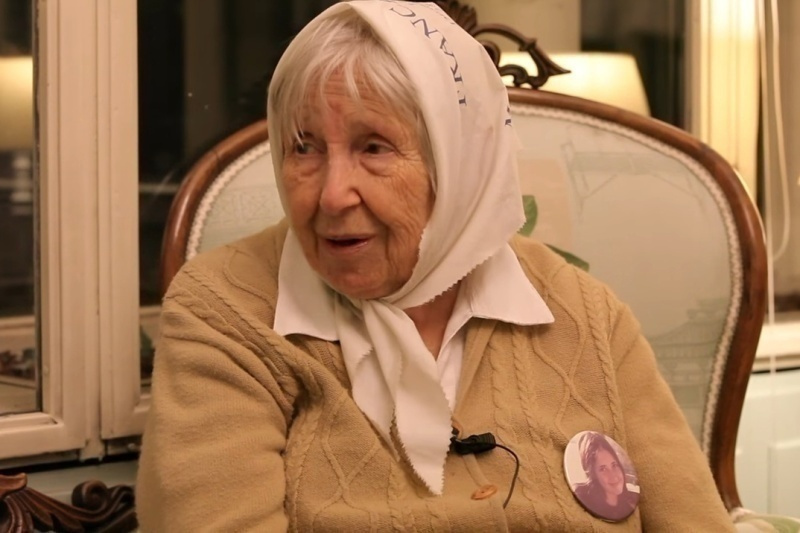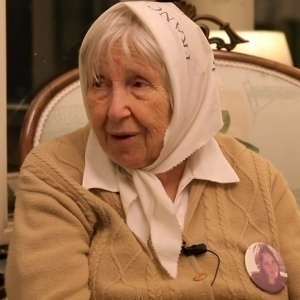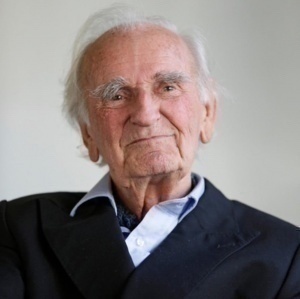Behind her melancholic gaze, Vera Vigevani Jarach hides the profound wounds marked by two dictatorships, which at different times deprived her of her dearest affections in heart-breaking ways. Her grandfather was deported and died in Auschwitz in 1943, her 18-year-old daughter was kidnapped, murdered and disappeared due to Argentinian coup militia just over three decades later. However, Vera’s life, marked by these two atrocious losses, is a paradigm of resistance to dictatorships and struggle for the preservation of remembrance. Every Thursday, for many years, she stopped working in the early afternoon to join the weekly demonstration of the “Mothers of the Plaza de Mayo”, of which she was one of the founders. The first roundabout of the Madres around the small pyramid in front of the Casa Rosada, seat of the government, dates back to 30th April 1977. Over time, that spontaneous movement of women united by the pain of losing their children would turn that square into the symbol of peaceful resistance to a regime that was annihilating an entire generation. Mutual solidarity for the shared condition of victims gave rise to fraternal friendships similar to those born in the years of the Second World War, within the small community of Italian Jewish refugees in Argentina.
Growing up in Milan with her sister, her father a lawyer and her mother a volunteer in a synagogue, Vera experienced the barbarity of fascist racial laws during her childhood. When she was only ten years old, in October 1938, she was expelled from public school along with many other Jewish children and teenagers. In those dramatic months, her family decided to leave Italy and find refuge in Argentina, waiting for better times. All except Vera’s grandfather, who decided not to leave. He did not want to give up his antiques business, his friendships and his habits and stayed in Italy. Soon he would be one of the many Milanese Jews who were deported to Nazi concentration camps: he ended up in Auschwitz, from where he never came back. Vera remained in Argentina with her parents even after the war, she finished her studies in an Italian school and started working as a cultural journalist in Ansa news agency. In her youth, she also became actively involved with other anti-fascist Jewish exiles. In 1949 she married Giorgio Jarach, a young engineer from Trieste, who had also fled Italy due to fascist persecution and in December 1957 their only daughter, Franca, was born.
During the terrible years of Jorge Rafael Videla’s dictatorship, a black and white photo of her smiling carefreely and heart-wrenchingly would become a regular presence in Plaza de Mayo and in the numerous demonstrations for the desaparecidos. For this 18-year-old girl, with her sweet eyes and strong temperament, eager for knowledge and confident of her ideals of justice, fate had reserved a violent kidnapping, clandestine imprisonment, torture, and eventually death. The military who had seized power with a coup d’état on 24th March 1976 were determined to bloodily repress any form of social conflict and Franca Jarach, a young activist of the collectives who dared to oppose the regime, was the predestined victim of a dictatorship that silently and inexorably began to wipe out young people, trade unionists, workers, intellectuals. Even when her kidnapping became an actual risk, Franca decided not to listen to her parents, who advised her to return to Italy, where they would join her. She decided to stay, just as her mother’s grandfather had done many years before. On 25th June 1976, the military stopped her in a bar and kidnapped her with some of her comrades. For her parents, engaged in a frantic and futile search, hope dawned just a fortnight later. They received a phone call from her that reassured them. She told them that she had been arrested but that she was fine, and that they would soon be notified to pick her up and bring her home. Vera and her husband only realised later, when talking with other families of disappeared persons, that this was a diversion adopted by the militia to stall the constant stream of people asking for news of their loved ones in the barracks and police stations. The girl’s fate would remain unknown for many years until 2000, when Marta Alvarez, a survivor of the regime’s concentration camps, was able to reconstruct her last tragic days. Franca’s imprisonment was short. About a month after her arrest, she was eliminated along with some of her mates to make room for new arrivals in torture chambers. Her body, like that of so many others, was thrown out of a plane. A few days after that reassuring phone call, the military forced her into the so-called “flight”, throwing her still alive into the ocean, or the immense Rio de La Plata river. A sadly common method, in those years, to get rid of the desaparecidos without leaving any trace of them.
Giorgio Jarach died in 1991, without receiving any news of his daughter. Vera continued for the rest of her life an unceasing activity in the Mothers of the Plaza de Mayo (the so-called “Linea fundadora” of the association, the one that accepted state reparations considering them to be useful to obtain truth and justice), but also in the Fundación Memoria Histórica y Social Argentina, in the association of the relatives of Jewish desaparecidos and in other minor entities. This work began to bear concrete fruit especially in 2003, with the abolition of the two laws of the “end point” and “due obedience”, which until then had guaranteed substantial impunity for the regime’s torturers. On 24th April 2008, the Court of Assizes in Rome confirmed on appeal the life sentence for Jorge Eduardo Acosta, Alfredo Ignacio Astiz, Jorge Raùl Vildoza, Antonio Vanek and Héctor Antonio Febres, the five Argentine naval officers serving during the dictatorship, known as Esma torturers. They were all found guilty of the kidnapping, torture and disappearance of a number of victims of Italian origin held in the notorious detention centre based at the Naval Academy in Buenos Aires. A long trial ended with sentences in absentia, which however had great symbolic value, during which Vera Vigevani Jarach travelled to Rome several times to give evidence. The elderly mother has always maintained that the story of the Argentinian desaparecidos cannot but also be considered as a chapter of Italian history. Both because the victims of the dictatorship included hundreds of Italians and people of Italian origin. And because the Italian diplomacy of the time was almost absent and thus played a negative role in the tragedy of the Argentinian dictatorship. As long as she has breath, Vera will continue to commit herself to remembrance on all occasions when she is called upon to speak, in schools, universities and public squares. Because her story is the tragic confirmation that - as Primo Levi said – “It happened, therefore it can happen again”. And it must continue to serve as a warning.











